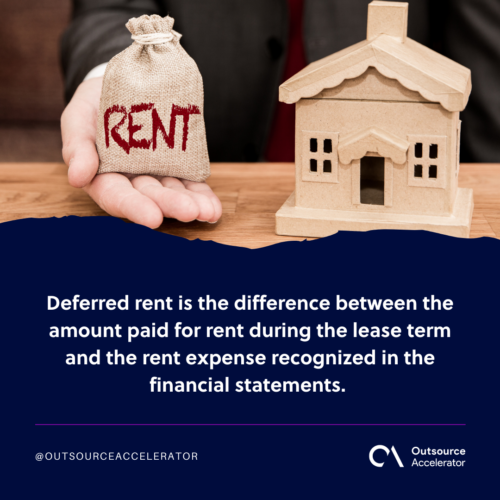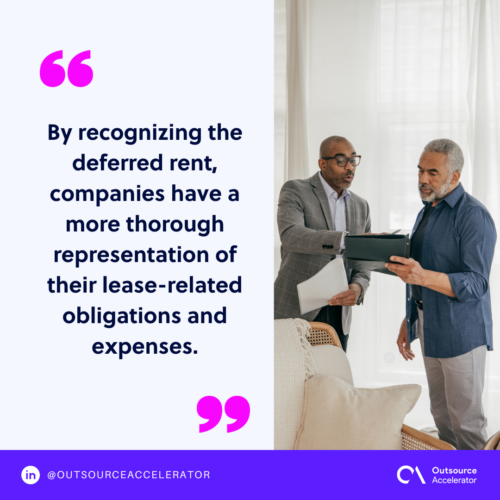Deferred rent for ASC 840 and ASC 842 explained

Leasing assets is a common practice for businesses, and the accounting for these leases can be complex. A crucial aspect of lease accounting is understanding how to record deferred rent.
In 2019, new rules were introduced under ASC 842 that significantly impacted how businesses recorded and accounted for lease liabilities.
This article serves as a guide on deferred rent and how it differs under ASC 840 and ASC 842. Learn why deferred rent is important and how to account for it.
What is deferred rent?
Deferred rent is the difference between the amount paid for rent during the lease term and the rent expense recognized in the financial statements.
This gap occurs when the accounting records’ straight-line rent expense differs from the rent paid to the landlord.
For example, a company leases a property for $120,000 per year and pays the full amount in year one of the lease agreement. The straight-line rent expense would be recorded as $100,000 ($120,000/12 months).
The $20,000 difference represents deferred rent recognized as an asset or liability on the balance sheet.

Deferred rent under ASC 840 vs. ASC 842
Under the previous accounting standard, ASC 840, deferred rent was recognized as a separate item on the balance sheet. It was the difference between the rent expense recognized on a straight-line basis and the actual rent payments made.
However, under ASC 842, leases are recorded on the balance sheet using a right-of-use (ROU) asset and a lease liability. As a result, the calculation of deferred rent has changed, as has the way it is recorded in the financial statements.
Under ASC 842, deferred rent is calculated as the difference between the recorded rent expense and cash payments made in the lease period. Unlike in ASC 840, deferred rent is not calculated using the straight-line method under ASC 842.
Deferred rent under ASC 840 example
A tenant receives free rent for a specific period as an incentive. The expense would typically spread over the lease term rather than be recognized immediately.
For example, a tenant signs a 12-month lease with three months of free rent. The monthly rent expense would then be recognized over the entire 15-month period.
Deferred rent under ASC 842 example
An example of deferred rent under ASC 842 would be when there are rent escalations over the lease term. The average rent expense and the percentage of the deferred rent liability should be billed each period.
How ASC 842’s changes impact deferred rent
The biggest change introduced by ASC 842 is the way leases are recorded on the balance sheet.
Previously, operating leases were disclosed in the footnotes of balance sheets, and only capital leases were recorded.
Under ASC 842, operating leases are now recorded as ROU assets and lease liabilities on the balance sheet.
This significantly impacts how deferred rent is calculated and recorded. As it is now calculated using the new lease accounting methodology.
Another significant change that came with ASC 842 is that deferred rent is now recorded as a component of the lease liability. Previously, it was recorded as a separate, standalone liability or asset.
Why is deferred rent important?
Deferred rent is important because it affects the financial statements of both landlords and tenants.
Firstly, it ensures accurate financial reporting and compliance with accounting standards. By recognizing the deferred rent, companies have a more thorough representation of their lease-related obligations and expenses.
Deferred rent also impacts key financial metrics and ratios. It affects EBITDA and operating income.
Proper acknowledgment of deferred rent enables stakeholders to make informed decisions based on reliable financial information. Moreover, it plays a significant role in lease negotiations and assessing a lease portfolio.
Analyzing the amount of deferred rent enables firms to evaluate the impact of lease terms and conditions on their financials. They can also make strategic decisions regarding lease renewals, expansions, or terminations.

Accounting for deferred rent
Companies need to follow a series of steps to account for deferred rent under ASC 842. These ensure accurate recognition and reporting in the lease agreement.
Here is an enumeration of the steps of deferred rent accounting:
- Identify lease contracts – The first step is to identify all lease contracts entered into by the company. This includes leases for real estate, equipment, or other assets.
- Determine the lease classification – Each lease contract must be assessed to determine whether it classifies as an operating or finance lease. This classification affects the treatment of deferred rent.
- Record lease liabilities – Firms should record a lease liability with the present value of future lease payments for operating leases. This liability incorporates the deferred rent portion.
- Recognize ROU assets – Simultaneously, businesses must recognize an ROU asset representing the right to use the leased asset over the lease term.
- Pay off lease liability and ROU assets – The lease liabilities and ROU assets should be paid over the lease term. The lease expense is then accepted along with the deferred rent component.
- Disclose supplementary information – Companies must disclose additional information related to their leases. This includes the amount of deferred rent recognized and any significant lease terms and conditions.







 Independent
Independent




